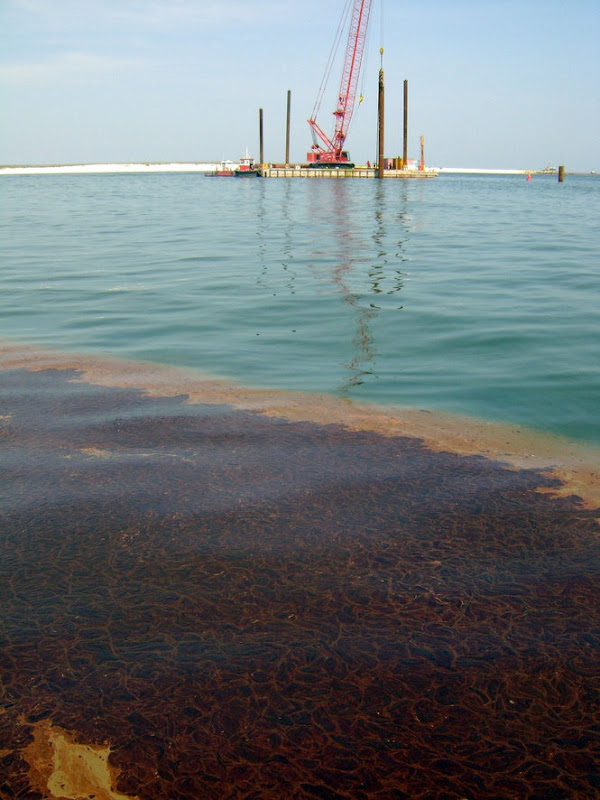Blown-out BP oil well gushes vast amounts of methane, could create Gulf ‘dead zones’
Associated Press Writers Matthew Brown and Ramit Plushnick-Masti authored this report. Brown reported from Billings, Mont.
Friday, June 18, 2010, 7:12 AM NEW ORLEANS — It is an overlooked danger in oil spill crisis: The crude gushing from the well contains vast amounts of natural gas that could pose a serious threat to the Gulf of Mexico’s fragile ecosystem. The oil emanating from the seafloor contains about 40 percent methane, compared with about 5 percent found in typical oil deposits, said John Kessler, a Texas A&M University oceanographer who is studying the impact of methane from the spill. That means huge quantities of methane have entered the Gulf, scientists say, potentially suffocating marine life and creating “dead zones” where oxygen is so depleted that nothing lives. “This is the most vigorous methane eruption in modern human history,” Kessler said. Methane is a colorless, odorless and flammable substance that is a major component in the natural gas used to heat people’s homes. Petroleum engineers typically burn off excess gas attached to crude before the oil is shipped off to the refinery. That’s exactly what BP has done as it has captured more than 7.5 million gallons of crude from the breached well. A BP spokesman said the company was burning about 30 million cubic feet of natural gas daily from the source of the leak, adding up to about 450 million cubic feet since the containment effort started 15 days ago. That’s enough gas to heat about 450,000 homes for four days. But that figure does not account for gas that eluded containment efforts and wound up in the water, leaving behind huge amounts of methane. … scientists are still trying to measure how much has escaped into the water and how it may damage the Gulf and it creatures. The dangerous gas has played an important role throughout the disaster and response. A bubble of methane is believed to have burst up from the seafloor and ignited the rig explosion. Methane crystals also clogged a four-story containment box that engineers earlier tried to place on top of the breached well. Now it is being looked at as an environmental concern. The small microbes that live in the sea have been feeding on the oil and natural gas in the water and are consuming larger quantities of oxygen, which they need to digest food. As they draw more oxygen from the water, it creates two problems. When oxygen levels drop low enough, the breakdown of oil grinds to a halt; and as it is depleted in the water, most life can’t be sustained. The National Science Foundation funded research on methane in the Gulf amid concerns about the depths of the oil plume and questions what role natural gas was playing in keeping the oil below the surface, said David Garrison, a program director in the federal agency who specializes in biological oceanography. “This has the potential to harm the ecosystem in ways that we don’t know,” Garrison said. “It’s a complex problem.” In early June, a research team led by Samantha Joye of the Institute of Undersea Research and Technology at the University of Georgia investigated a 15-mile-long plume drifting southwest from the leak site. They said they found methane concentrations up to 10,000 times higher than normal, and oxygen levels depleted by 40 percent or more. The scientists found that some parts of the plume had oxygen concentrations just shy of the level that tips ocean waters into the category of “dead zone” — a region uninhabitable to fish, crabs, shrimp and other marine creatures. Kessler has encountered similar findings. Since he began his on-site research on Saturday, he said he has already found oxygen depletions of between 2 percent and 30 percent in waters 1,000 feet deep. Shallow waters are normally more susceptible to oxygen depletion. Because it is being found in such deep waters, both Kessler and Joye do not know what is causing the depletion and what the impact could be in the long- or short-term. In an e-mail, Joye called her findings “the most bizarre looking oxygen profiles I have ever seen anywhere.” … Steven DiMarco, an oceanographer at Texas A&M University who has studied a long-known “dead zone” in the Gulf, said one example of marine life that could be affected by low oxygen levels in deeper waters would be giant squid — the food of choice for the endangered sperm whale population. Squid live primarily in deep water, and would be disrupted by lower oxygen levels, DiMarco said.
Overlooked BP oil spill problem: Well gushes vast amounts of methane, could create Gulf ‘dead zones’
